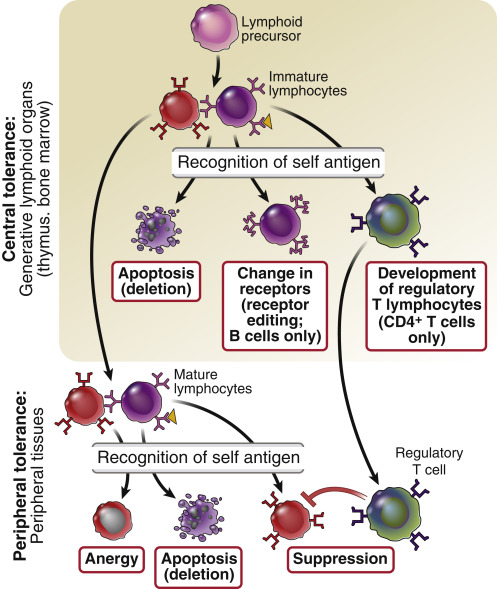
What is immunological tolerance?
- When specific lymphocytes confront antigens, there are two possibilities:
- 1) The lymphocytes may be activated resulting to the immune responses.
- 2) The lymphocytes may be inactivated or eliminated, leading to tolerance.
- The immune system employs many layers of protection in order to prevent the reaction of its cells and antibodies against host components which is termed as tolerance.
- Antigens inducing tolerance are termed as tolerogens or tolerogenic antigens rather than immunogens.
- On the basis of how and where the antigens are presented to the immune system, it can act as both the immunogen and a tolerogen.
- One of the fundamental properties of the normal immune system is self-tolerance.
- Self-tolerance is term given for the tolerance to self-antigens.
- In adults, most lymphocytes encounter with foreign antigen lead to an immune response aimed at elimination.
- But in case of foetus, due to the immature state of the immune system, exposure to antigens frequently leads to tolerance.
What are the factors promoting immunological tolerance?
- Regardless of foetal exposure, factors that promote immunological tolerance rather than stimulation of the immune system by a given antigen include the following:
- High doses of antigen
- Long-term persistence of antigen in the host
- Intravenous or oral introduction
- Absence of adjuvants (compounds that enhance the immune response to antigen)
- Low levels of co-stimulation
- Presentation of antigen by immature or in-activated antigen-presenting cells (APCs)
Importance of Immunological tolerance:
- Immunological tolerance plays significant role and is important for various reasons.
- In immunological tolerance, the lymphocytes that recognize self-antigens are either killed or inactivated, or their specificity is altered.
- This way, the individual becomes tolerant of self-antigens.
- Immunological tolerance plays role as therapeutic approach for the prevention of harmful immune responses.
- Also, induction of tolerance might also be helpful for the prevention of immune reactions to the products of newly expressed genes in gene therapy protocols.
Types and mechanisms of immunological tolerance:
- Tolerance is an immunologically specific phenomenon.
- When the specific lymphocytes recognize the antigens, it results in tolerance.
- The self-tolerance induction may occur either in immature self-reactive lymphocytes in primary lymphoid organs (central tolerance) or in mature lymphocytes in peripheral sites (peripheral tolerance).

Central tolerance:
- The first step for tolerance is the central tolerance.
- In central tolerance, if the T- or B-cell clones possess receptors that identifies self-antigens with high affinity, these cells are deleted before their maturation.
- It takes place in primary lymphoid organs (the bone marrow for B cells and thymus for T cells).
- However, central tolerance fails to account for unresponsiveness to antigens which are expressed only in peripheral tissues.
- Hence, peripheral tolerance mechanisms are induced for maintaining tolerance to such tissue-specific self-antigens.
- The occurrence of central tolerance takes place as the lymphocytes in course of maturation in the generative lymphoid organs, pass through a stage in which their encounter with antigen results in cell death or the expression of new antigen receptors or alteration in functional capabilities.
- Only self-antigens are present in the thymus and bone marrow.
- It is because the foreign antigens are not transported to the thymus.
- Instead, it is captured and migrated to peripheral lymphoid organs, such as the lymph nodes, spleen, and mucosal lymphoid tissues.
- Thus, the developing lymphocytes normally interacts only with self-antigens in the primary lymphoid organs.
- This encounter of immature lymphocytes with self-antigens has several possible outcomes:
- Cells may die by apoptosis
- Undergo deletion
- In case of B cells, it changes its specificity and in case of T cells, it develops into regulatory tolerance
Peripheral tolerance:
- The occurrence of peripheral tolerance takes place when the mature lymphocytes that recognize self-antigens loses its ability to respond to that antigen, or lose their viability and become short-lived cells, or are induced to die by apoptosis.
- The importance of peripheral tolerance is listed as:
- To maintain unresponsiveness to self-antigens that are expressed in peripheral tissues and not in primary lymphoid organs.
- For the tolerance to self-antigens that are expressed in adult life after the production of mature lymphocytes.
- The mature lymphocytes repertoire consists of cells able to recognize such self-antigens.
- The responses of the mature lymphocytes to these antigens are strictly regulated to maintain self-tolerance.
- However, it is still unclear which self-antigens induce central or peripheral tolerance.
- The basic principle is that the choice between lymphocyte activation and tolerance is determined by the properties of the antigens, by the state of maturation of the antigen-specific lymphocytes, and by the types of stimuli received when these lymphocytes encounter self-antigens.
What is Antigen sequestration?
- Along with the mechanisms of central and peripheral tolerance, an effective way to avoid self-reactivity is sequestration (compartmentation) of antigens.
- For instance, the anterior chamber and lens of the eye are regarded as sequestered sites, without lymphatic drainage.
- It also possess tissue-specific privileged antigens that are generally kept apart from interaction with immune cells.
- This sequestration enables these antigens to avoid encounter with reactive lymphocytes under normal circumstances; if the antigen is not exposed to immune cells, there is little possibility of reactivity.
- However, one possible outcome of sequestration is that the antigen is never encountered by developing lymphocytes, and thus active tolerance to the sequestered antigen is not established.
- If barriers between immune cells and the sequestered antigens are ruptured (for example by trauma), the newly released antigen may be taken as foreign as it was not previously encountered.
- Trauma to one eye that permits entry of immune cells can lead to inflammation in that eye, causing tissue destruction and impaired vision.
- In these cases, the other eye may also become inflamed due to the sudden entry of clones of these recently activated immune cells identifying newly discovered tissue-specific antigens.
- This is not to convince that a lack of exposure to the immune system is the only factor that mediates immune privilege.
- A locally immunosuppressive microenvironment in tissues is traditionally considered immune privileged, such as the eye and central nervous system (CNS).
- In addition to other active mechanisms, it is believed to bias the immune response toward tolerance in these locations.
